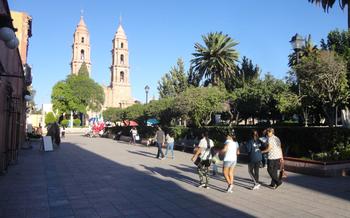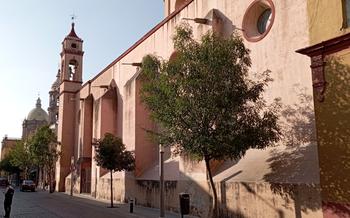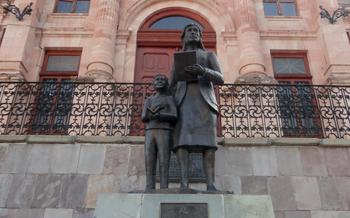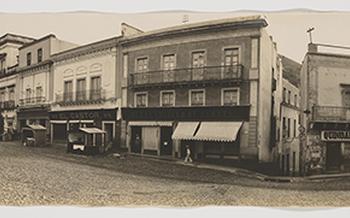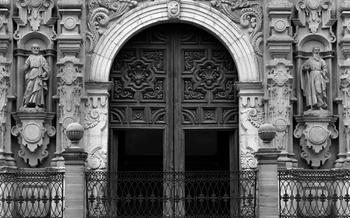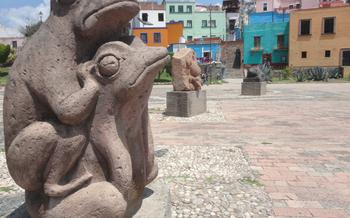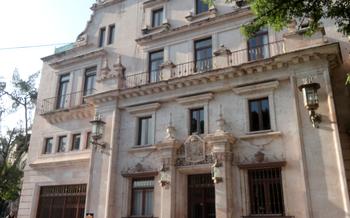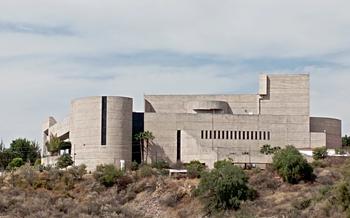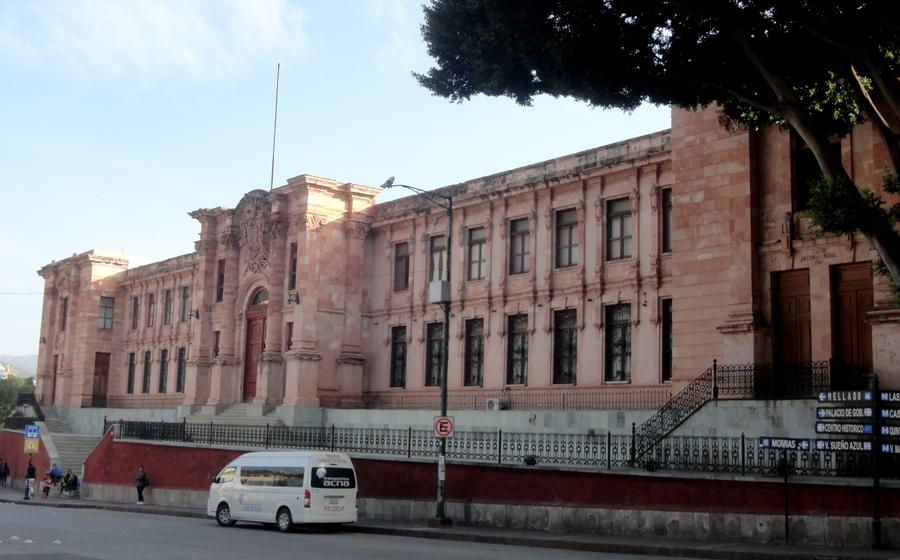
Guanajuato University Staircase (Escalinata de la Universidad de Guanajuato)
- Location and Accessibility
- The 99 Steps: A Symbol of Perseverance
- Personal anecdote:
- The Scenic Views from the Top
- Admire the Neoclassical Architecture
- The University of Guanajuato
- The Cultural Significance of the Staircase
- The Guanajuato International Film Festival
- The Diego Rivera Murals
- The Mummy Museum
- The Jardín de la Unión: Heart of Guanajuato's Social Scene
- Insider Tip: Guanajuato's Culinary Delights
Location and Accessibility
The Guanajuato University Staircase is a prominent landmark located in the heart of Guanajuato city, Mexico. Its exact address is Calle Alonso No. 12, Zona Centro, 36000 Guanajuato, Gto. To reach this iconic site, visitors can opt for various transportation options. The most convenient way is to explore the city on foot, as it is situated within the historic center and is easily accessible from most attractions. Alternatively, local buses and taxis are readily available to take you to the university's vicinity.
For those arriving by car, finding parking can be challenging due to the narrow streets and limited parking spaces in the city center. It is advisable to park your vehicle in one of the designated parking lots on the outskirts of the historic center and then proceed on foot to the staircase. This will allow you to fully immerse yourself in the city's vibrant atmosphere and appreciate its colonial architecture as you make your way towards the university.
Insider tip: To avoid the crowds and fully appreciate the tranquility and beauty of the staircase, plan your visit during the early morning hours or on weekdays when there are fewer tourists.
The 99 Steps: A Symbol of Perseverance
The Guanajuato University Staircase, also known as the "99 Steps," holds a profound symbolic meaning beyond its architectural significance. The number 99 has been the subject of much speculation and folklore. Some believe it represents the 99 years it took to build the staircase, while others associate it with the 99 steps leading to enlightenment in Buddhist philosophy.
The challenge of climbing the 99 steps is not merely a physical one; it is a metaphor for the obstacles and trials one must overcome to achieve success. Each step represents a hurdle, a difficulty that must be conquered in the pursuit of one's goals. The sense of accomplishment upon reaching the top is immense, a testament to the strength and determination of the human spirit.
Personal anecdote:
In my own experience, climbing the 99 steps was both physically demanding and deeply symbolic. As I ascended, I couldn't help but reflect on the challenges I had faced in my own life. Each step was a reminder that perseverance and determination were the keys to overcoming adversity. The feeling of triumph and accomplishment I felt at the top was a powerful reminder that any challenge could be overcome with the right mindset.
The Scenic Views from the Top
Ascending the Guanajuato University Staircase is not just a physical challenge but also a rewarding experience that unveils panoramic vistas of Guanajuato city. From the top, visitors are greeted with a breathtaking cityscape, where colorful colonial buildings cascade down the surrounding hills, creating a picturesque mosaic. The majestic spires of churches and the lush green mountains in the distance add to the charm of the scenery.
Every step climbed is worth it for the Instagrammable moments that await at the summit. The staircase offers multiple vantage points to capture the essence of Guanajuato's beauty. Whether you prefer panoramic shots of the cityscape or close-ups of the intricate architectural details, the views from the top are sure to impress.
One of the best times to visit the Guanajuato University Staircase is during sunset, when the golden hues of the setting sun cast a warm glow on the city, transforming it into a magical spectacle. The play of light and shadow creates a unique ambiance, making it an ideal time to soak in the beauty of Guanajuato from above.
Admire the Neoclassical Architecture
The Guanajuato University Staircase showcases exquisite Neoclassical architecture, characterized by its symmetry, clean lines, and intricate details. Admire the finely carved balustrades adorned with elegant motifs, cherubs, and mythical creatures. The staircase's facade features stately columns, arches, and pediments, creating a harmonious composition.
Pay attention to the elaborate sculptures that adorn the staircase, each telling a unique story. Look for the figure of Minerva, the Roman goddess of wisdom, perched atop the central arch, symbolizing the university's dedication to knowledge.
The Neoclassical style of the staircase reflects the architectural trends of the late 18th and early 19th centuries, when it was constructed. Guanajuato's rich silver mining history during this period influenced the city's architectural development, resulting in the construction of grand buildings like the university.
As you ascend the staircase, take a moment to appreciate the architectural masterpiece that surrounds you. The Guanajuato University Staircase stands as a testament to the city's rich cultural heritage and architectural prowess.
The University of Guanajuato
The Guanajuato University is an institution of higher learning with a rich history and academic reputation. Founded in 1732, it is one of the oldest universities in Mexico. The university offers a diverse range of undergraduate and graduate programs, including law, medicine, engineering, and the arts. It is renowned for its academic excellence and has produced many notable alumni who have made significant contributions to Mexican society.
The university campus is located in the heart of Guanajuato City and is a UNESCO World Heritage Site. The historic buildings, courtyards, and gardens create a stunning and inspiring learning environment. The university is also home to several cultural centers, museums, and theaters, making it a vibrant hub of intellectual and artistic activity.
While visiting the Guanajuato University Staircase, take some time to explore the university campus. Take a stroll through the courtyards, visit the museums, or attend a lecture or performance. The university is a treasure trove of knowledge and culture, and you will undoubtedly be impressed by its rich history and academic achievements.
The Cultural Significance of the Staircase
The Guanajuato University Staircase transcends its architectural and historical significance to become a profound symbol of Guanajuato's rich cultural heritage. It's deeply entwined with local traditions and celebrations, serving as a focal point for community gatherings, festivals, and religious processions. The staircase's grandeur and symbolic meaning have inspired countless works of art, literature, and music, capturing the essence and spirit of Guanajuato.
In my personal experience, I witnessed the staircase's cultural significance firsthand during the annual Cervantino International Festival. The staircase transformed into a vibrant stage, hosting live performances, theatrical acts, and musical concerts that showcased the city's artistic diversity. The atmosphere was electric, with locals and tourists alike immersing themselves in the cultural extravaganza. This experience reinforced my appreciation for the staircase's role in fostering Guanajuato's vibrant cultural identity.
The Guanajuato International Film Festival
Guanajuato is renowned for its vibrant cultural scene, and one of its highlights is the Guanajuato International Film Festival. This prestigious event, held annually, attracts filmmakers, actors, and movie enthusiasts from around the world. The festival showcases a diverse range of films, from independent and experimental works to mainstream blockbusters, offering a platform for emerging and established talent.
Venues throughout the city host screenings, workshops, and special events during the festival. The historic Teatro Juárez, with its opulent interior, serves as the main venue, while other theaters, cultural centers, and outdoor spaces are utilized to accommodate the growing number of attendees.
The Guanajuato International Film Festival has significantly contributed to the city's reputation as a cultural hub. It provides a platform for local and international filmmakers to showcase their work, fostering collaboration and exchange within the global film community. The festival also attracts a large number of tourists, boosting the local economy and promoting Guanajuato as a vibrant and cosmopolitan destination.
Personal anecdote:
I had the privilege of attending the Guanajuato International Film Festival during my stay in the city. The atmosphere was electric, with people from all walks of life coming together to celebrate their love of cinema. I was particularly impressed by the diversity of the films on offer, from thought-provoking documentaries to visually stunning feature films. The festival provided a unique opportunity to engage with filmmakers, attend workshops, and experience the city's vibrant cultural scene firsthand.
The Diego Rivera Murals
Within the sprawling complex of the University of Guanajuato, one can find a hidden gem that attracts art enthusiasts worldwide: the Diego Rivera murals. Created by the renowned Mexican artist in the early 20th century, these murals are a testament to Rivera's unique style and his deep connection to Mexican history and culture.
Rivera's murals adorn the walls of the university's central patio, inviting viewers into a vibrant and evocative world. The murals depict scenes from Mexico's rich past, showcasing moments of triumph, struggle, and cultural identity. With his bold brushstrokes and vibrant colors, Rivera brings to life historical figures, indigenous traditions, and the essence of the Mexican spirit.
Each mural tells a story, whether it's the conquest of Mexico by the Spanish conquistadors, the Mexican Revolution, or the vibrant daily life of the Mexican people. Rivera's mastery of composition and his ability to capture the emotions and expressions of his subjects create a powerful narrative that resonates with viewers to this day.
Visiting the Diego Rivera murals is an opportunity to immerse oneself in the artistic genius of one of Mexico's most celebrated artists. These murals offer a glimpse into the country's complex history and cultural heritage, making them a must-see for anyone interested in Mexican art and culture.
Personal anecdote:
As I stood before the Diego Rivera murals, I couldn't help but feel a sense of awe and inspiration. The sheer size and grandeur of the murals were breathtaking, and the intricate details and symbolism drew me in. I spent hours studying each panel, marveling at Rivera's ability to capture the essence of Mexico's past and present.
What struck me most was Rivera's deep love for his country. Through his murals, he pays homage to Mexico's rich history, its struggles, and its triumphs. He celebrates the strength and resilience of the Mexican people and their unwavering spirit.
Visiting the Diego Rivera murals was a profound experience that left a lasting impression on me. They are a testament to the power of art to educate, inspire, and unite people, and they stand as a symbol of Mexico's rich cultural heritage.
The Mummy Museum
The Mummy Museum is one of Guanajuato's most unique and intriguing attractions, housing a collection of over 100 naturally mummified bodies that were discovered in the local cemetery. These mummies, dating back to the 19th century, provide a glimpse into the past and offer a fascinating insight into the region's history and culture.
The museum is located just a short walk from the Guanajuato University Staircase, in the heart of the city. Its collection includes mummies of all ages and social backgrounds, each with their own story to tell. Visitors can learn about the mummification process, the causes of death, and the social and cultural practices of the time.
The most striking aspect of the museum is the sheer number of mummies on display. The bodies are arranged in various positions, some standing, some sitting, and others lying down. Their remarkably preserved features, along with their clothing and personal belongings, create a sense of intimacy and connection with the past.
One particularly intriguing mummy is that of a young woman known as "La Novia" (The Bride), who was buried in her wedding dress. Her story is especially poignant, as she is believed to have died on her wedding day. The museum also houses the mummy of a man who was killed by a bull, with his horns still embedded in the victim's skull.
The Guanajuato Mummy Museum offers a unique and thought-provoking experience, inviting visitors to reflect on the fragility of life and the enduring power of memory. It is a must-visit for anyone interested in history, culture, and the mysteries of the human body.
The Jardín de la Unión: Heart of Guanajuato's Social Scene
Nest square that embodies the city's rich cultural heritage and lively atmosphere. Surrounded by elegant colonial buildings, this enchanting garden serves as a social hub for locals and visitors alike.
Strolling through the Jardín de la Unión, you'll encounter an array of historical monuments and landmarks that tell the story of Guanajuato's past. Admire the majestic Teatro Juárez, with its neoclassical facade and grand interior, or marvel at the intricate details of the Templo de San Francisco, a testament to the city's religious devotion.
As the sun sets, the garden transforms into a lively gathering place, where street performers entertain the crowds with music, dance, and acrobatics. Local vendors line the perimeter, offering a tempting array of traditional Mexican snacks and souvenirs. The air fills with the sounds of laughter, chatter, and the sweet melodies of mariachi bands.
Take a seat on one of the many benches scattered throughout the garden and soak in the vibrant ambiance. Watch as children chase pigeons, couples stroll hand-in-hand, and friends gather for animated conversations. The Jardín de la Unión is a place where the past and present intertwine, creating a unique and unforgettable experience for all who visit.
Personal Anecdote:
On my first visit to Guanajuato, I spent hours wandering through the Jardín de la Unión, captivated by its energy and charm. I stumbled upon a group of musicians playing traditional Mexican music, and their infectious rhythm drew me in. As I listened to the lively melodies, I felt a sense of joy and connection to the city's vibrant spirit. That evening in the Jardín de la Unión remains one of my most cherished memories of Guanajuato, a city that truly knows how to celebrate life.
Insider Tip: Guanajuato's Culinary Delights
Beyond its historical and cultural attractions, Guanajuato is a haven for food enthusiasts. The city's culinary scene is vibrant and diverse, offering a range of local dishes and specialties that tantalize the taste buds. From traditional Mexican fare to international cuisine, Guanajuato has something to cater to every palate.
Be sure to sample the local specialty, "enchiladas mineras," which are enchiladas filled with a delicious combination of potatoes, cheese, and guajillo chili sauce. Other must-try dishes include "pozole," a hominy-based soup, and "tacos al pastor," spit-roasted pork tacos.
For a culinary adventure, head to the Mercado Hidalgo, a bustling market where you can find fresh produce, local delicacies, and traditional sweets. You can also explore the city's many restaurants, from family-run eateries to fine-dining establishments.
My personal anecdote: I stumbled upon a small, unassuming restaurant in the heart of the city. The aroma of freshly made tortillas and sizzling meats wafted through the air, drawing me inside. I ordered a plate of enchiladas mineras, and I was blown away by the explosion of flavors in every bite. The combination of the tender chicken, tangy sauce, and soft tortillas was simply divine.
Guanajuato's culinary delights are not to be missed, so embrace your inner foodie and indulge in the city's gastronomic offerings. From street food stalls to upscale restaurants, there's something for everyone to savor.
